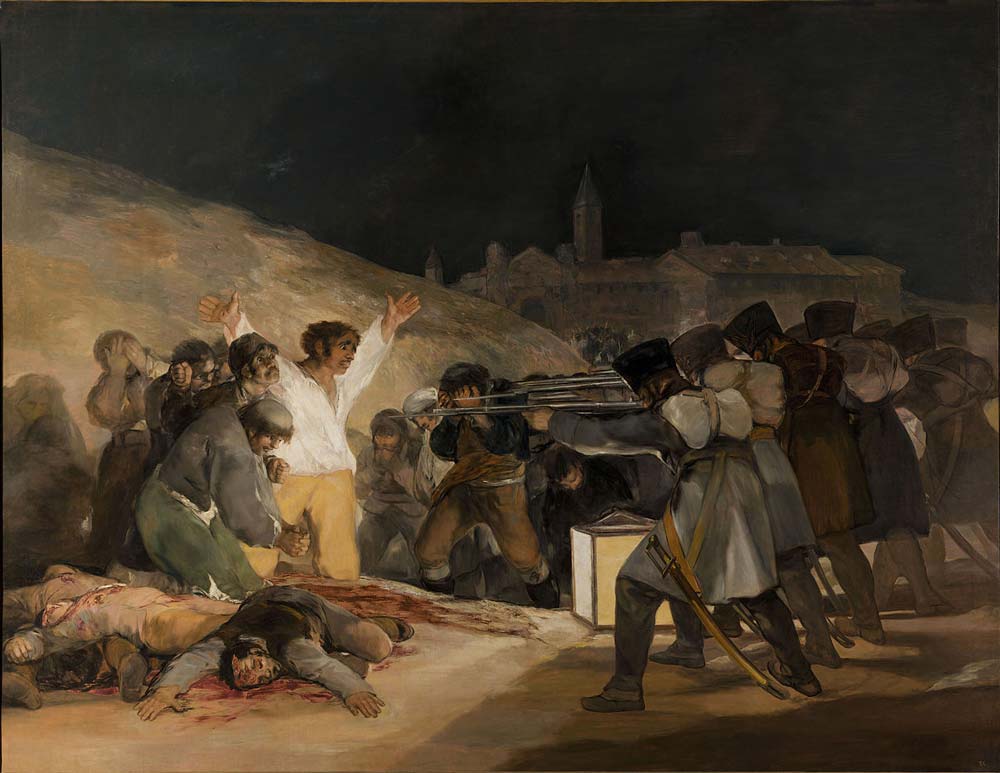| The Third of May 1808 | |
|---|---|
 |
|
| Artist | Francisco de Goya |
| Year | 1814 |
| Medium | Oil on canvas |
| Location | Museo del Prado, Madrid |
| Dimensions | 106 in × 137 in |
| 268 cm × 347 cm | |
| Famous Paintings by Goya | |
| Saturn Devouring His Son | |
| The Third of May 1808 | |
| La Maja Desnuda | |
| The Sleep of Reason Produces Monsters | |
| Witches’ Sabbath | |
| La Maja Vestida | |
| La Cometa | |
| The Forge | |
| The Dog | |
| Complete Works |
The Third of May 1808 is a precisely crafted oil on canvas painting that was completed in 1814 by reputed Spanish painter Francis Goya to commemorate Spanish victory over the armies of the brutal Napoleon. It is one of the most famous paints that carry a heavy message of liberation and one of the most instant reminders of the battle of Spain’s freedom.
The Napoleon invasion (in Spain) lasted from 1808 to 1814 and had a profound effect on Goya, who, being the vivid communicator he was, chose to integrate his experiences into his artistic works. In addition to The Third of May 1808, he also made another descriptive painting dubbed The Second of May depicting the initial invasion of Spain territory by the domineering French armies under the watch of Napoleon Bonaparte.
A Bloody Scene
The Third of May 1808 is famed for its expressive and highly symbolic setting. It features a bloody encounter with about six Napoleon army men pointing their rifles towards helpless Spanish rebels ready to execute them. One Spanish rebel is seen with his hands held up in the air as a sign of surrender, about two Spanish men lie on a pool of blood and several others seem to be struck in panic mode.
The background seems dark (it appears to be a nighttime or evening setting) and there appears to be some source of light directed towards the rebels perhaps to provide the French soldiers with a better view of their target.
It depicts a scene of ambush in a bushy hideout pitting well-equipped foreign soldiers attacking a local crude-equipped guerilla force.
The scenes depicted in this painting are believed to be a dramatized version of what exactly took place during the initial days of the historic Spanish invasion.
Focus
In this painting, Goya shifted our vantage so that we more directly face the victims while Napoleon’s soldiers’ faces are obscured. This is perhaps to increase our sympathy towards the victims and to reduce the individuality of the soldiers. Our eyes are drawn to a young man in yellow pants and a white shirt who display mighty yet fragile bravery readiness to face his doom.
It is a scene of martyrdom–a feat that is believed to have formed the foundations of the much celebrated Spanish freedom.
Goya’s Works
Before the Spanish invasion, most of Goya’s works were designed to decry common social and geo-political issues like corruption, folly, and irrationality. However, on a closer look, the events that took place during the six year long war period seem to have added a different twist to his works. Most of his works completed after 1814 were much darker both emotionally and visually.
His monumental war paintings have won him worldwide recognition. He is arguably more respected due to the impartial nature of his job. In most of his historical paintings, he focused on bringing out the basest human instincts and sufferings rather than taking sides. He not only chose to convey symbolic messages, but also to carry them across in a realistic and vivid manner.